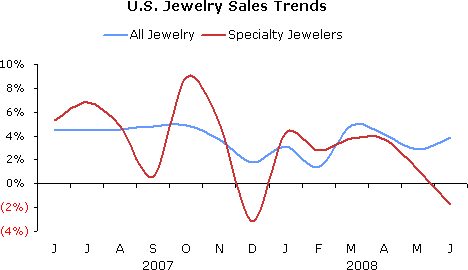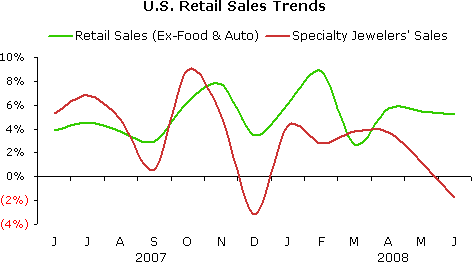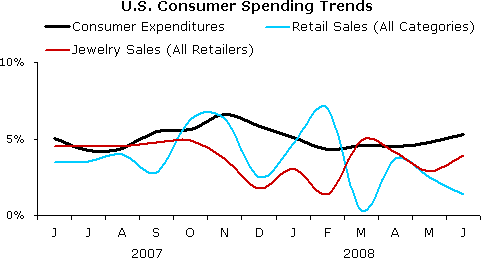IDEX Online Research: U.S. Jewelry Sales Show Modest Gain, Specialty Jewelers Lose Share
August 18, 08
While total jewelry sales showed modest growth in June, specialty jewelers – from the big chains to the small independents – apparently lost significant market share. Total jewelry sales in all retail outlets grew by just under 4 percent in June, but specialty jewelers’ sales declined by nearly 2 percent, based on preliminary figures from the U.S. government.
The table below summarizes jewelry sales comparisons as well as total retail sales trends in the U.S. market.
June 2008 – Monthly Sales Trends
- +3.9 percent - Total U.S. Jewelry Sales
- (1.7 percent) - Total U.S. Specialty Jewelers’ Sales
- +1.4 percent - Total U.S. Retail Sales (All Categories)
- +5.2 percent - Total U.S. Retail Sales (Ex-Auto & Food)
Why did specialty jewelers fare so poorly in June? Jewelry consumers are “shopping down” – they are buying smaller stones and opting for less ostentatious settings (white gold rather than platinum, for example). Thus, the average ticket is smaller. In addition, they are shopping at retailers which are clearly discounters, rather than specialty jewelers who, despite their continuous price-based promotions, simply don’t sell jewelry as inexpensively as a Wal-Mart or some other discounters.
Three-Month Trends Weak
For the past three months, U.S. consumers have been tightening their purse strings as a result of six key factors: 1) a softening economy; 2) a housing slowdown and declining prices (a house is no longer an ATM machine); 3) a credit crunch (credit is much harder to obtain); 4) soaring energy prices; 5) uncertain financial markets; and, 6) a growing “green” movement (resulting in less conspicuous consumption and fewer trips to cathedrals of consumption).
The table below summarizes retail sales trends for the past quarter:

Source: Various
Jewelry Sales Forecast Remains Unchanged
Our jewelry sales forecast for the U.S. market in 2008 remains unchanged at +3 percent. However, this could prove to be an aggressive prediction since fundamental jewelry demand has weakened and jewelry price inflation has moderated recently.
After six months, total jewelry sales are up 3.4 percent, while specialty jewelers’ sales are up 2.2 percent. Despite these respectable, though moderate gains, current trends are not hopeful. We believe, however, that economic conditions in the second half won’t get significantly worse, and could improve. While many doomsday-sayers are predicting the worse, they forget two key factors: 1) the U.S. economy is more resilient today than ever before; and, 2) we’ve learned a thing or two about how to fix a troubled economy.
June Jewelry Sales Show Moderate Gain
The total market for jewelry in the U.S. grew by 3.9 percent rate during June. That’s not bad, considering that there is no major sales event driving demand. However, specialty jewelers suffered with a sales decline of 1.7 percent for the month. Unfortunately, these figures confirm once again that specialty jewelers lost market share in June versus their competition from non-traditional sources of jewelry such as discounters, mass marketers, and others.
However, the jewelry industry gained market share when compared to all retail categories. Total retail sales (all goods, including food and automobiles) eked out a very modest 1.4 percent gain in June, dragged down by weak auto sales. Total retail sales, excluding food and automobiles, rose by a solid 5.2 percent in June. Thus, when compared to most retail categories, except food and automobiles, the jewelry industry – and specialty jewelers – lost market share during the month.
The graph below compares specialty jewelers’ sales trends (red line) to total jewelry sales trends (blue line) in the U.S. market. As the graph clearly illustrates, jewelry sales at specialty jewelers have been on a roller coaster ride for the past few months, with a sharp slide in September, a spike in October, another slide in November and December, followed by a modest recovery in January, a small dip in February, and a modest recovery in March and April. In May, jewelry sales gains weakened substantially, followed by a major drop in June.

Source: U.S. Dept. of Commerce
The graph below summarizes sales trends for all retail goods (green line) excluding food and automobiles versus specialty jewelers’ sales (red line). When food and auto sales are excluded, the remaining retail categories posted a sales gain of 5.2 percent in May. When food and auto sales are included, retail sales were up 1.4 percent for the month, as previously indicated.
Why do we eliminate “automobile” sales? Monthly auto sales are driven largely by consumer incentives rather than by underlying economic factors. Over the long term, auto demand trends are an important indicator of consumer vitality; however, on a month-to-month basis, auto demand is dependent on manufacturers’ incentives such as zero percent financing, cash-back offers and other deals. Food sales are far less cyclical and can mask changes in consumer demand; thus, we eliminate them, too.

Source: U.S. Dept. of Commerce
Consumer Spending Was Up Slightly in June
Driven by price inflation of core commodities such as gasoline and food, consumer expenditures rose by 5.3 percent during June 2008, up slightly from May’s +4.8 percent (revised). Further, the government numbers have been revised for the first six months of the year; they show a different – and more hopeful – trend from prior months. Spending on services remains more-or-less on track, with little monthly deviation.
The graph below summarizes trends in American’s total spending (black line), retail sales of all goods (blue line) and expenditures on jewelry (red line). It is clear that dismal automobile sales in the U.S. market are having a dramatic negative impact on total retail sales (blue line). Automobile sales in 2007 were just over 20 percent of total retail sales; thus, it is clear why they have such an impact on total retail sales trends. And, it should be obvious why we typically eliminate them, when we analyze U.S. retail sales. Automobile sales are driven largely by the “deal-of-the-day,” as we noted above.

Source: U.S. Dept. of Commerce
2008 Jewelry Sales Forecast Unchanged
While the economy is not technically in a recession – first and second quarter economic growth was anemic, but still slightly positive – consumers are in a mental recession. As a result, jewelry demand is soft. Further, the government recently revised its economic figures for the fourth quarter of 2007, and determined that economic growth was negative in that three-month period. Most jewelers already knew that!
Primarily because of inflationary pressures, our jewelry sales forecast for the U.S. calls for a +3 percent gain for 2008. We continue to believe that specialty jewelers could report sales slightly in excess of this gain, while multi-line retailers who sell jewelry will likely experience smaller gains, though current trends would suggest otherwise. There is one important note: all jewelers are expected to sell fewer pieces of jewelry (if inflation remains in the 8-9 percent range, it means that unit sales of jewelry will be down 5 percent or so); further, we are assuming that the average ticket doesn’t move much.